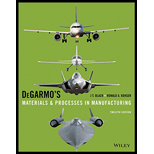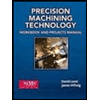
DeGarmo's Materials and Processes in Manufacturing
12th Edition
ISBN: 9781118987674
Author: J. T. Black, Ronald A. Kohser
Publisher: WILEY
expand_more
expand_more
format_list_bulleted
Question
Chapter 20, Problem 51RQ
To determine
The explanation for residual compressive stresses imparted during chemical tempering of glass.
Expert Solution & Answer
Want to see the full answer?
Check out a sample textbook solution
Students have asked these similar questions
The cardiovascular countercurrent heat exchnager mechanism is to warm venous blood from 28 degrees C to 35 degrees C at a mass flow rate of 2 g/s. The artery inflow temp is 37 degrees C at a mass flow rate of 5 g/s. The average diameter of the vein is 5 cm and the overall heat transfer coefficient is 125 W/m^2*K. Determine the overall blood vessel length needed too warm the venous blood to 35 degrees C if the specific heat of both arterial and venous blood is constant and equal to 3475 J/kg*K.
The forces Qy=12 kNQy=12kN and Qz=16 kNQz=16kN act on the profile at the shear center C. Calculate:
a) Shear flow at point B (2 points)b) Shear stress at point D (3 points)
Consider the feedback controlled blending system shown below, which is designed to keep theoutlet concentration constant despite potential variations in the stream 1 composition. The density of all streamsis 920 kg/m3. At the nominal steady state, the flow rates of streams 1 and 2 are 950 and 425 kg/min,respectively, the liquid level in the tank is 1.3 m, the incoming mass fractions are x1 = 0.27, x2 = 0.54. Noticethe overflow line, indicating that the liquid level remains constant (i.e. any change in total inlet flow ratetranslates immediately to the same change in the outlet flow rate). You may assume the stream 1 flowrate andthe stream 2 composition are both constant. Use minutes as the time unit throughout this problem.
d) Derive the first order process and disturbance transfer functions;Gp= Kp/(tou*s+1) and Gd=Kd/(tou*s+1) and calculate and list the values and units of the parameters.
e) Using the given information, write the general forms of Gm, GIP, and Gv below(in terms of…
Chapter 20 Solutions
DeGarmo's Materials and Processes in Manufacturing
Ch. 20 - Why are the fabrication processes applied to...Ch. 20 - How does the fabrication of a shaped product from...Ch. 20 - What are some of the methods used to shape...Ch. 20 - What are some of the ways that plastic sheet,...Ch. 20 - Prob. 5RQCh. 20 - What types of polymers are most commonly blow...Ch. 20 - What are some common blow molded products, in...Ch. 20 - Why do blow molding molds typically contain a...Ch. 20 - Prob. 9RQCh. 20 - Prob. 10RQ
Ch. 20 - Prob. 11RQCh. 20 - Prob. 12RQCh. 20 - Prob. 13RQCh. 20 - Prob. 14RQCh. 20 - Prob. 15RQCh. 20 - What are some of the benefits of a hot runner...Ch. 20 - Why is the cycle time for the injection molding of...Ch. 20 - Prob. 18RQCh. 20 - Prob. 19RQCh. 20 - What are some of the ways by which a polymer...Ch. 20 - Prob. 21RQCh. 20 - How can the extrusion process be used to produce...Ch. 20 - Prob. 23RQCh. 20 - Prob. 24RQCh. 20 - Prob. 25RQCh. 20 - What is the difference between open-cell and...Ch. 20 - Prob. 27RQCh. 20 - What types of products are produced by...Ch. 20 - Prob. 29RQCh. 20 - What are some of the general properties of...Ch. 20 - What are some of the attractive features of laser...Ch. 20 - What property of plastics is responsible for...Ch. 20 - Prob. 33RQCh. 20 - Prob. 34RQCh. 20 - Prob. 35RQCh. 20 - Prob. 36RQCh. 20 - Prob. 37RQCh. 20 - Prob. 38RQCh. 20 - Why might threaded inserts be preferred over other...Ch. 20 - What are some of the ways in which metal inserts...Ch. 20 - Prob. 41RQCh. 20 - Why does locating a parting line on a sharp corner...Ch. 20 - Prob. 43RQCh. 20 - Prob. 44RQCh. 20 - Prob. 45RQCh. 20 - What property changes occur during vulcanization?Ch. 20 - Prob. 47RQCh. 20 - Prob. 48RQCh. 20 - How are glass fibers produced?Ch. 20 - Prob. 50RQCh. 20 - Prob. 51RQCh. 20 - What are glass-ceramics? How are they produced?Ch. 20 - Prob. 53RQCh. 20 - Describe the differences between the injection...Ch. 20 - Prob. 55RQCh. 20 - What is the difference between slip casting and...Ch. 20 - Prob. 57RQCh. 20 - Prob. 58RQCh. 20 - How does cementation differ from sintering?Ch. 20 - What are the benefits and limitations of machining...Ch. 20 - Prob. 61RQCh. 20 - Why are joining operations usually avoided when...Ch. 20 - Prob. 63RQCh. 20 - Discuss some of the design guidelines that relate...Ch. 20 - Prob. 65RQCh. 20 - Why are the processes used to fabricate...Ch. 20 - How are metals and ceramics combined in the...Ch. 20 - What are some of the processes that can be used to...Ch. 20 - What conditions might be attractive for...Ch. 20 - Prob. 70RQCh. 20 - Prob. 71RQCh. 20 - Prob. 72RQCh. 20 - Prob. 73RQCh. 20 - What are some of the ways that liquefied matrix...Ch. 20 - Prob. 75RQCh. 20 - Prob. 76RQCh. 20 - Prob. 77RQCh. 20 - In what way is pultrusion similar to wire drawing?Ch. 20 - Prob. 79RQCh. 20 - What are some typical products that are made by...Ch. 20 - Prob. 81RQCh. 20 - Prob. 82RQCh. 20 - Prob. 83RQCh. 20 - Prob. 84RQCh. 20 - Prob. 85RQCh. 20 - Prob. 86RQCh. 20 - What is the difference between reaction injection...Ch. 20 - Prob. 88RQCh. 20 - Prob. 89RQCh. 20 - What is a common property objective in...Ch. 20 - Prob. 91RQCh. 20 - Prob. 92RQCh. 20 - Prob. 93RQCh. 20 - What is the major concern when considering the...Ch. 20 - Prob. 95RQCh. 20 - Prob. 1PCh. 20 - Figure 20.A depicts the handles of two large...Ch. 20 - Tires are the dominant product of the rubber...Ch. 20 - Prob. 4PCh. 20 - Prob. 6PCh. 20 - Prob. 8PCh. 20 - Prob. 1CSCh. 20 - For plastic (high-density polyethylene)...Ch. 20 - What might be the pros and cons of weldable...Ch. 20 - Prob. 5CSCh. 20 - Prob. 6CSCh. 20 - Prob. 7CSCh. 20 - Crashworthiness is an important safety...Ch. 20 - Prob. 9CSCh. 20 - Prob. 10CSCh. 20 - Prob. 11CS
Knowledge Booster
Learn more about
Need a deep-dive on the concept behind this application? Look no further. Learn more about this topic, mechanical-engineering and related others by exploring similar questions and additional content below.Similar questions
- a) Briefly explain what ratio control is. Give an example of a common chemical engineering situation in whichratio control would be useful and for that example state exactly how ratio control works (what would bemeasured, what is set, and how the controller logic works).b) Briefly explain what cascade control is. Give an example of a common chemical engineering situation inwhich cascade control would be useful and for that example state exactly how cascade control works (whatwould be measured, what is set, and how the controller logic works).arrow_forwardDetermine the reaction force acting on the beam AB, given F = 680 N. 5 4 4 m 3 3 A B 30° 3 m F (N)arrow_forwardThe frame in the figure is made of an HEA 300 profile (E = 210 GPa, material S355).a) Determine the support reactions at point A. (1p)b) Sketch the bending moment diagram caused by the loading. (1p)c) Using the principle of virtual work (unit load method), calculate the vertical displacement at point B using moment diagrams. Also take into account the compression of the column. (3p)arrow_forward
- 9 kN/m 6 kN/m 3 m 6 m Bestäm, med hjälp av friläggning och jämviktsberäkningar, tvärkrafts- och momentdiagram för balken i figuren. Extrempunkter ska anges med både läge och värde.arrow_forwardB C 3.0 E F G 40 kN [m] 3.0 3.0 3.0 Fackverket belastas med en punktlast i G enligt figuren. Bestäm normalkraften i stängerna BC, BF och EF.arrow_forwardL q=8 kN/m P= 12 kN En stång belastas av en punklast P vid sin ena ände samt av en jämnt utbredd last q längs hela sin längd. Stången har en tvärsnittsarea A = 150 mm² och är tillverkad av stål med elasticitetsmodul E-210 GPa. Stångens längd, i sitt obelastade tillstånd, är Z-3 m. a) Hur stor är den största normalspänning som uppstår i stången? b) Hur stor blir förlängningen av stången, orsakad av lasterna P och q?arrow_forward
- A turbocharged engine with a compression ratio of 8 is being designed using an air standard cycle. The ambient air is assumed to be 300K and 100 kPa. The temperature at the end of the compression in the cylinder is desired to be 1000K, assuming no combustion prior to reaching TDC. At the end of the cylinder expansion the temperature is also desired to be 1000K. If both the turbine and the compressor have mechanical efficiencies of 80%, what will be the pressure ratio of the compressor and what will be the turbine exhaust temperature?arrow_forwardQ6: A turbocharged engine with a compression ratio of 8 is being designed using an air standard cycle. The ambient air is assumed to be 300K and 100 kPa. The temperature at the end of the compression in the cylinder is desired to be 1000K, assuming no combustion prior to reaching TDC. At the end of the cylinder expansion the temperature is also desired to be 1000K. If both the turbine and the compressor have mechanical efficiencies of 80%, what will be the pressure ratio of the compressor and what will be the turbine exhaust temperature?arrow_forwardQ5: A 5.6 litre V8 engine with a compression ratio of 9.4:1 operates on an air-standard Otto cycle at 2800 RPM, with a volumetric efficiency of 90 % and a stoichiometric air-fuel ratio using gasoline. The exhaust flow undergoes a temperature drop of 44ºC as it passes through the turbine of the supercharger. Calculate (a) mass flow rate of exhaust gas and (b) power available to drive the turbocharger compressor.arrow_forward
arrow_back_ios
SEE MORE QUESTIONS
arrow_forward_ios
Recommended textbooks for you
 Precision Machining Technology (MindTap Course Li...Mechanical EngineeringISBN:9781285444543Author:Peter J. Hoffman, Eric S. Hopewell, Brian JanesPublisher:Cengage Learning
Precision Machining Technology (MindTap Course Li...Mechanical EngineeringISBN:9781285444543Author:Peter J. Hoffman, Eric S. Hopewell, Brian JanesPublisher:Cengage Learning

Precision Machining Technology (MindTap Course Li...
Mechanical Engineering
ISBN:9781285444543
Author:Peter J. Hoffman, Eric S. Hopewell, Brian Janes
Publisher:Cengage Learning
Intro to Ceramics and Glasses — Lesson 2, Part 1; Author: Ansys Learning;https://www.youtube.com/watch?v=ArDFnBWH-8w;License: Standard Youtube License